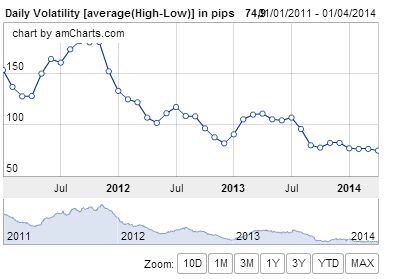Is Your Strategy Affected by Shifting Volatility?
Markets never stay the same for long. Your trading may be going very well for a time, and then all of a sudden more losing trades start popping up. You haven’t changed anything, so why will your strategy all of a sudden stop working? While it isn’t always the case, a lot of times it has to do with volatility.
Volatility Changes?
Changes in volatility can have a big impact on your strategy results. If you created your strategy during a “quiet” time in the market, and it worked well, an increase in volatility could hurt you. Similarly, if you created your strategy during a volatile time, and it worked well, a decrease in volatility could hurt you.
I noticed this recently while day trading forex. Volatility has been dropping steadily in the EURUSD since late 2012 (and many other forex pairs). My day trading strategies which attempt to capture strong momentum haven’t been fairing as well, because the “pops” in price just aren’t as strong as they used to be…on average.
Figure 1. EURUSD Long-Term Volatility

Source: http://vantagepointtrading.com/daily-forex-stats
Figure 1 shows average daily volatility in pips since 2011, through to April 2014. In late 2012 the average daily movement was more than 150 pips. That means if you picked a decent entry the price was likely to run a fair distance, which leaves a lot of margin for error. For binary options you can choose an expiry that is 5 minutes away or 10 minutes away and it probability isn’t going to affect performance too much since the price is moving strongly.
Progress to 2014 and the average daily movement is about 60 to 75 pips. Typically these moves are choppier and don’t run as far. And when price isn’t running, and instead moving in a move choppy fashion, that means the difference between choosing a 5 or 10 minute expiry can be the difference between profit and loss.
A Solution?
There is a solution. If your strategy is designed for more volatility, you may need to increase the time frame you trade on.
For me, I like day trading on a 1-minute or 5-minute chart, but recently have found much greater success trading on a 1-hour or daily chart. My trades typically last a day to three days (as opposed to 10 or 15 minutes). Notice how three days of trading at the current volatility, equals 1 day of volatility back in 2011. Therefore, by taking trades that last a day or more, I am able to capture similar amounts of volatility as seen on a daily basis in 2011.
If we start to see an increase in volatility again, I will move more focus back to trading on shorter time frames (I still do trade on shorter timeframes, just not as much).
Traders who find success in quiet markets, like now (April, 2014), may have less success in a volatile market. They too may need to adjust their time frame in order to compensate.
The ultimate the goal is to notice when your performance is being affected by volatility, and make an adjustment for it.
It should be noted that we are looking at averages here. Just because the daily average volatility is dropping doesn’t mean we don’t see big volatility days–we do see them, on occasion.
As traders we need to be on the ball and notice how the day is shaping up. Is it going to be volatile? Are we seeing strong movements? Or is it quiet and we are seeing small movements? These types of questions will determine what type of time frame we trade on.
If you aren’t seeing relevant trends (which make trading easier) on the shorter time frame, switch to a longer one. Regardless of whether volatility increases or decreases, keep your strategies functioning by monitoring volatility and adjusting your timeframe to compensate for these volatility fluctuations.